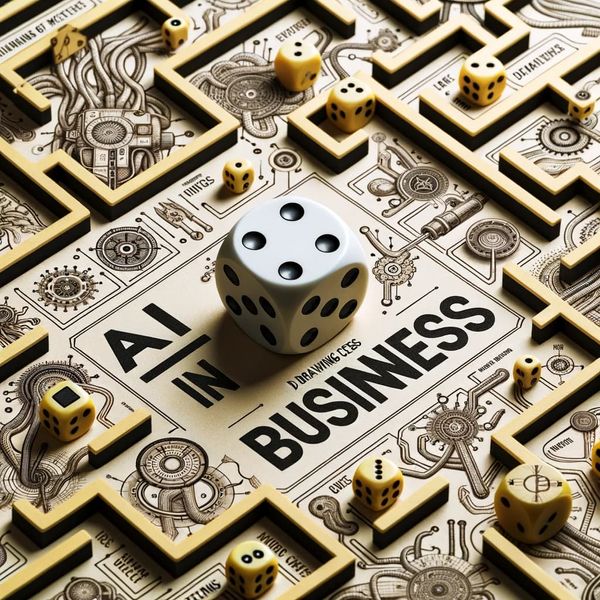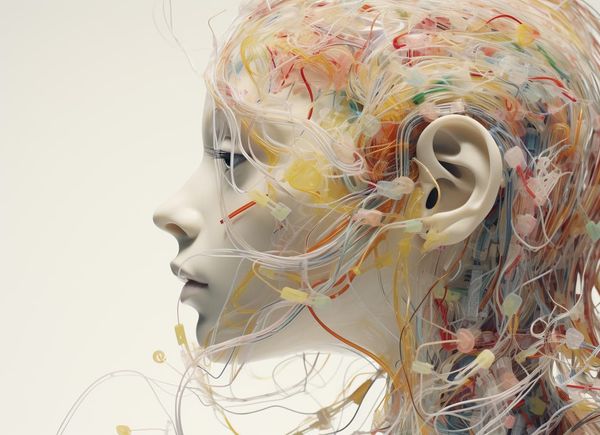There's an often-unspoken belief that sophisticated and intricate technology should be accompanied by an equally complex interface. This notion is rooted in the idea that groundbreaking capabilities necessitate a level of intricacy in interaction, reflecting the depth of the underlying mechanics.
However, ChatGPT debunked this conventional "wisdom". Despite being powered by one of the most advanced artificial intelligence models in existence, its interface was refreshingly simple, mirroring the everyday chat platforms familiar to millions.
This stark contrast between profound technological complexity and user-friendly design showed that OpenAI's understanding that true innovation doesn't lie in creating barriers with intimidating interfaces but in making cutting-edge technology accessible, intuitive, and seamlessly integrated into the human experience.
TLDR;
- ChatGPT's simple and familiar chat interface played a pivotal role in its meteoric rise, not just the advanced AI capabilities.
- The choice of a chat format allowed anyone to converse intuitively with the AI, lowering barriers to entry.
- Simplicity in the design meant no complex menus or settings - just start chatting. This ease of use drove adoption.
- The chat interface was reminiscent of popular messaging apps, tapping into familiarity. This helped users trust the new technology.
- ChatGPT's success has sparked an industry race to develop conversational AIs. Competitors are creating their own chatbots with unique capabilities.
- While chat interfaces may not fully replace complex web designs, they could transform UI/UX by streamlining interactions. Conversational interfaces will likely grow.
- ChatGPT struck an optimal balance of simplicity and familiarity in its interface. This user-centric ethos contributed immensely to its viral adoption and influence. It has set a new gold standard for conversational AI design.
AI Behind Closed Doors
Generative AI breakthroughs actually predate the release of ChatGPT. As early as 2017, Google published a seminal paper titled "Attention Is All You Need" that introduced transformer models for natural language processing. These models marked a major advance in neural networks' ability to process language data.

Then in 2020, OpenAI unveiled GPT-3, which leveraged transformers to achieve state-of-the-art performance on text generation tasks. Models like GPT-3 demonstrated remarkable progress in generative AI - AI that can create human-like text, images, and code.
However, interacting with GPT-3 still required technical knowledge and coding skills. The average user could not simply have a conversation with these early generative models without an intermediary interface.
Opening the Floodgates
The release of ChatGPT in late 2022 fundamentally changed this status quo. ChatGPT offered an intuitive conversational interface to a powerful generative AI system.
Here was an AI system capable of dazzling feats of natural language generation, but accessible to all through a disarmingly simple conversational interface.
Suddenly, no specialized knowledge was needed to engage in natural dialogue with an AI and access its capabilities. From composing poems to explaining scientific concepts, ChatGPT provided coherent responses on demand through plain English conversation.
Questions were met with coherent, nuanced responses on topics ranging from poetry to public policy. This glimpse behind the curtain captivated the public imagination, spreading like wildfire. For the first time, advanced AI felt tangible and within reach, sparking awe and excitement instead of apprehension.
ChatGPT allowed anyone to try out open-ended conversations with an AI assistant, sparking public imagination and enthusiasm.
The Magic Behind ChatGPT's Viral Growth
When we reflect on the elements that catalyzed ChatGPT's explosive popularity, it becomes clear that the interface played a pivotal role.
But what made this interface so irresistibly enticing to users worldwide? Let's dissect the essential components of ChatGPT's interface and understand how they propelled its meteoric rise.
When it comes to technology, user adoption often hinges on two critical factors: simplicity and familiarity. The rise and success of ChatGPT’s chat interface offer a compelling testament to this principle. Let’s delve deeper into these elements to understand their profound impact on user experiences.
The Choice for Conversation
Language is the cornerstone of human connection. From cave paintings to epic tales recited around ancient campfires, and now to the flurry of messages exchanged in today's digital age — communication in language is what has always defined us. It’s how we share stories, convey emotions, and build relationships.
When one thinks of the immense capabilities of generative AI, it's easy to imagine a plethora of complex interfaces, intricate designs, and flashy presentations. And yet, ChatGPT took a different path.
OpenAI recognized the sheer elegance and universality of the chat format. Instead of wrapping GPT-3 in layers of contemporary design and features, they honed in on the pure essence of conversation. By doing so, they didn't just build an AI tool; they crafted a digital conversationalist.
This decision to fine-tune GPT-3 specifically for the chat interface wasn't mere happenstance. These were deliberate design and technical choices. By doing so, ChatGPT didn’t alienate users with unnecessary complications or demand they learn new interfaces. Everyone, irrespective of their tech-savviness, could easily converse with this cutting-edge AI, just as they would with another person.
We are often bombarded with technology that often feels distant or impersonal, but ChatGPT's approach felt refreshing human-centric. It harks back to our roots and captures the essence of what makes us truly human: our innate desire to communicate and connect. Through its minimalist chat interface, ChatGPT reminds us that sometimes, the most powerful connections don't come from the most intricate designs, but from the simplest conversations.
The Elegance of Simplicity
As Leonardo da Vinci once said, "Simplicity is the ultimate sophistication." This couldn't be more true in the realm of tech design. The most groundbreaking of technologies can falter if users are faced with a steep learning curve.
ChatGPT excelled in this domain. By encapsulating the vastness of GPT-3's capabilities within a straightforward chatbox, it transformed a complex AI interaction into a simple conversation.
Infact, the first iteration of ChatGPT's interface presented (distracted) the user with very few options, other than a basic conversational box, the options to delete and create a new chat.
There were no intimidating commands, no perplexing settings—just type and get a response. It was as simple as texting a friend about weekend plans. This ease of use ensured that users, regardless of their tech-savviness, could harness the power of GPT-3 without any hiccups.
Success Was Not Promised
GPT-3, the powerful engine behind ChatGPT, was already being harnessed by a plethora of applications like JasperAI, Chatsonic, Rytr, and more. Each of these tools leveraged GPT-3's generative capabilities to produce content across diverse domains.
And while their functionality was commendable (indeed I used many of them in daily life), none quite tapped into the fundamental human experience of conversation. They operated as tools, not as companions.
Had OpenAI taken a similar route and presented GPT-3 as just another generative tool without the chat interface, ChatGPT might have easily been lost in the cacophony of similar offerings.
It could have been sidelined as a technological marvel appreciated by a few but not adopted by the masses. The choice of a chat interface wasn’t just a design decision; it was a strategic move that placed ChatGPT squarely at the intersection of technology and human interaction.
The simplicity of the chat format allowed users, regardless of their technical prowess, to engage with the AI seamlessly. It eliminated barriers to entry, inviting everyone to experience the marvel of Generative AI without the intimidation of complex interfaces.
Moreover, in a time where many tech products vie for attention with feature bloat and intricate designs, ChatGPT's chat interface stood out for simplicity and user-centric design. It was a reminder that sometimes, the most powerful innovations are those that feel the most familiar as we will see shortly.
The Allure of the Familiar
From the books we read to the foods we eat, familiarity plays a silent yet formidable role in our choices. In cognitive psychology, this is often referred to as the 'mere exposure effect,' where people tend to develop a preference for things merely because they are familiar with them.
For ChatGPT, the chat interface bore striking similarities to the myriad of messaging apps that have become a staple in our digital lives:
- Slack
- Facebook Messenger
- Telegram
- Viber
- Discord
- Google Chat
- MS Teams
This resemblance wasn't just cosmetic; it played a pivotal role in fostering user trust. When presented with a new technology, especially something as advanced as artificial intelligence, users can feel overwhelmed or even intimidated.
By offering an interface reminiscent of WhatsApp, Telegram, or iMessage, the initial apprehension was effortlessly dissolved.
ChatGPT Paving the Way for a New Era of Conversational AIs
Since its inception, ChatGPT has not only awed audiences with its linguistic prowess but has also ignited an industry-wide race to develop advanced conversational AIs.
Several tech entities, sensing the immense potential, have ventured into creating their versions of language models in the form of chatbots. ChatGPT’s success has created a ripple effect, inspiring a slew of other LLM-based chatbots, each with its nuances and unique offerings.
Let’s delve into how ChatGPT influenced some of the market's most popular chatbot platforms.
You.com: A user-centric search engine that efficiently curates the internet's highlights while prioritizing privacy. This platform streamlines search by presenting information in a tailored interface, integrating innovative features like the ChatGPT-inspired YouChat, a writing tool, and an AI art generator. Beyond its user-friendly design, You.com minimizes ad intrusiveness, encourages personalized logins, and offers browser plugins for an enhanced, seamless search experience.
Poe.com is an AI-driven chat app, facilitating real-time conversations with various AI models like GPT-4 and Claude from Anthropic. It offers both free and subscription-based bots, billing subscription costs to the user's Apple ID. Poe also features a web interface, syncing chats across devices. In contrast,

Pi.ai, developed by Inflection AI, is a personal AI chatbot tailored to be more than just an information provider. Representing "personal intelligence", Pi offers a blend of emotional support, advice, and knowledge tailored to an individual's interests. Unlike other AIs focused on productivity or search, Pi emphasizes human-like interactions, embedding kindness, diplomacy, and humour into its conversations. Serving as a coach, confidant, or creative partner, Pi continually adapts to its user. Accessible via pi.ai on desktops or through its dedicated App Store app, it stands out as a free personal bot dedicated to understanding and aiding its users.

Claude.ai, crafted by Anthropic, is a cutting-edge AI assistant designed to function as a friendly and proactive colleague or personal aide. Using natural language, users can guide Claude through a myriad of tasks via its chat interface and developer API. Claude's versatility covers areas like summarization, creative writing, coding, and Q&A. It stands out due to its reliability, predictable responses, and ability to be steered with minimal effort. Users can even tailor Claude's personality and tone. Not only is Claude seen as an improvement over other chatbots, but it also dabbles in diverse tasks, from poetry to business strategy.

Perplexity.ai, designed by Perplexity AI, Inc., is an innovative AI-driven search platform that delivers real-time answers from up-to-date sources. Distinct features of Perplexity.ai include:
- Instantaneous answers with cited sources for any query
- Integration of AI and internet search for accurate results
- Context-aware responses ensuring personalized answers
- A user-centric interface
- Availability as an iPhone app.
What sets Perplexity apart is its unique capability to understand and factor in the context of a conversation, ensuring not just generic but tailored responses. This has positioned it as a platform offering more comprehensive and precise answers compared to other AI solutions.
Bard, an experimental AI chatbot from Google, was built on the foundation of the LaMDA language models and later evolved with the PaLM LLM. Launched in March 2023, initially as a competitor to OpenAI's ChatGPT, its debut garnered mixed reactions before it broadened its reach in May. Bard integrates vast global knowledge with Google's LLM capabilities. It serves as a tool for both creative inspiration and in-depth learning, facilitating deeper insights into various topics. Unique to Bard, users can cross-check its responses on Google Search or explore web sources. Capable of coding, solving math problems, and assisting in writing, Bard's distinctive feature compared to ChatGPT is its ability to extract information directly from the web. Its engine now runs on Google's most sophisticated LLM, PaLM 2.

While all these platforms have their individual strengths and market positioning, their common ancestry can be traced back to ChatGPT. ChatGPT's groundbreaking interface and conversational finesse served as a blueprint, demonstrating the vast potential of LLMs when packaged in user-friendly formats.
The Evolution of Web/App Design?
The emergence of AI-powered chat interfaces has prompted a pivotal question in the world of web design: Could these simplistic yet effective interfaces replace intricate web designs? And more importantly, does the traditional chat interface have a role to play in enterprise applications?
Historically, intricate web designs emerged as a means to cater to diverse functionalities, ensuring that users could navigate myriad options and processes. These designs often reflect the complexity of business operations and the various tasks that users need to perform. However, with the advent of generative AI, there's a tangible shift in how we approach user interactions.
Chat interfaces, like ChatGPT, have demonstrated the profound capability of AI to understand context, extract information, and respond in real-time. This offers a streamlined, singular point of interaction, replacing the need for multiple menus, dropdowns, and buttons. For end-users, this means a simpler and more intuitive interaction model. Instead of navigating through multiple pages or tabs, users can simply state their needs and get instant results.
When considering enterprise applications, the potential is vast. Imagine an enterprise resource planning (ERP) system where instead of browsing through layers of menus, a user can simply type, "Show me the sales data for Q2," or "Update the inventory for product X." This could revolutionize the user experience by making systems more accessible, reducing training requirements, and speeding up processes.
However, it's essential to strike a balance. While a chat interface is revolutionary, there are tasks and processes where visual interfaces, charts, or specific design elements might be more effective. In scenarios requiring data visualization, for example, a graphical dashboard might convey information more effectively than a textual chat response.
That said, the proliferation and ease of implementing generative AI could indeed pivot the UI/UX landscape towards a more conversational paradigm. As AI models become more advanced, understanding nuanced requests and handling multifaceted tasks, the integration of chat interfaces in both consumer and enterprise applications will likely become more prevalent.
A Nod to Midjourney - Paving the Path for AI Conversations
Before ChatGPT made waves with its chat-based interface, there was Midjourney.
As an AI image generation app that debuted over a year before ChatGPT, Midjourney offered a unique take on how users could communicate with technology.
Operating on Discord, a popular chat platform, Midjourney harnessed the potential of chat as its primary user interface. While it didn't exactly mirror the organic chat experience that ChatGPT would later popularize, it laid the essential groundwork.
At the heart of Midjourney's interface was a command-based system. Users seeking to generate images had to initiate their requests with specific commands, followed by a natural language description of their desired image.
For instance, instead of simply stating "an image of a serene beach at sunset," users might need to begin with a command, such as "/imagine," followed by the description.
Though this command-based system added an extra layer to the interaction, the underlying principle remained revolutionary. Midjourney demonstrated that powerful AI tools could be controlled and accessed through chat platforms.
In many ways, it set the stage for the full-blown conversational AI experiences that we see today.
While ChatGPT simplified and fine-tuned the process, it's essential to acknowledge Midjourney's pioneering role in this narrative, serving as a testament to the innovative strides in the world of AI.
Takeaway, Setting the Gold Standard
ChatGPT's rise to prominence is not solely attributed to its state-of-the-art GPT-3 engine but more so to its acute grasp of user psychology. By blending simplicity with familiarity,
ChatGPT crafted a setting where users not only felt at ease but also felt empowered. This emphasis on user-centricity propelled ChatGPT into becoming the tech marvel we recognize today. Even in the age of AI, we must keep in mind, the essence of making technology both accessible and resonant with the masses.
The success narrative of ChatGPT is more than just a triumph of technology; makes clear the critical role of presentation and user experience in shaping a product's destiny. A deviation in OpenAI's approach could have dramatically altered not just ChatGPT's trajectory but the entire tech ecosystem's fabric.
While the debate persists on whether AI-driven chat interfaces can wholly supplant intricate web designs, there will be an undeniable shift in the UI/UX paradigm. Marrying the straightforwardness of chat with the depth of traditional design, we stand on the brink of a transformative era where technology becomes more user-friendly and instinctive.
Lastly, the legacy of ChatGPT extends beyond its own achievements. It has set a precedent, acting as a beacon for subsequent conversational AI endeavours. Its ethos and foundational principles are poised to influence, if not shape, the direction of future chatbot innovations, emphasizing heightened accessibility, finesse, and relevance in an ever-evolving digital landscape.












